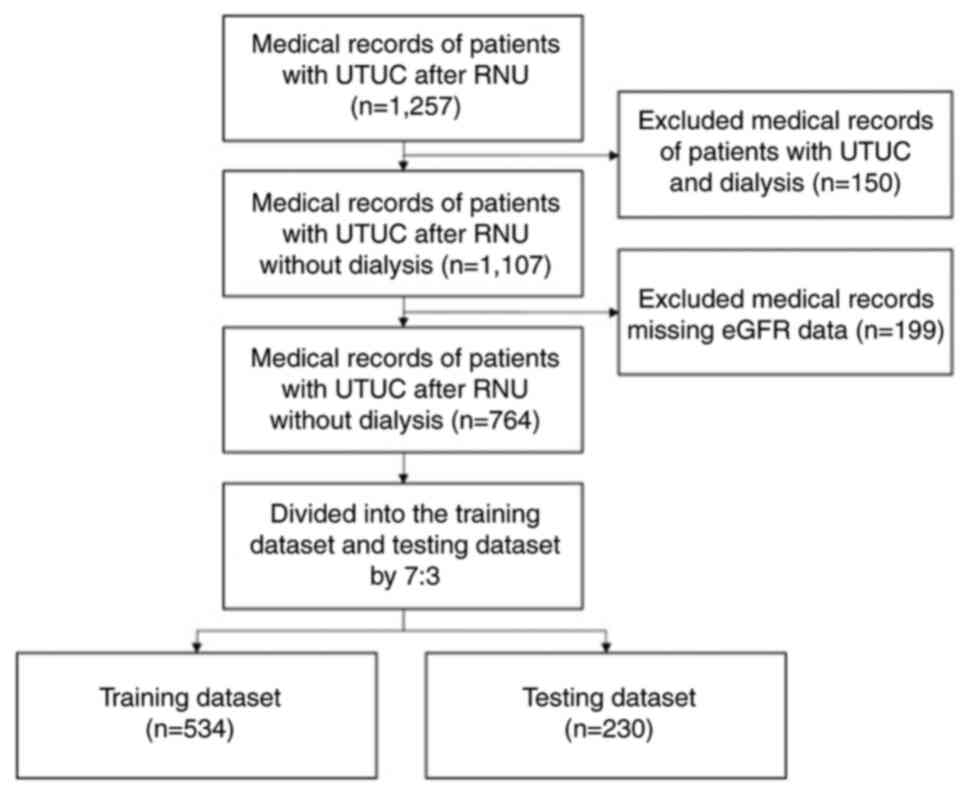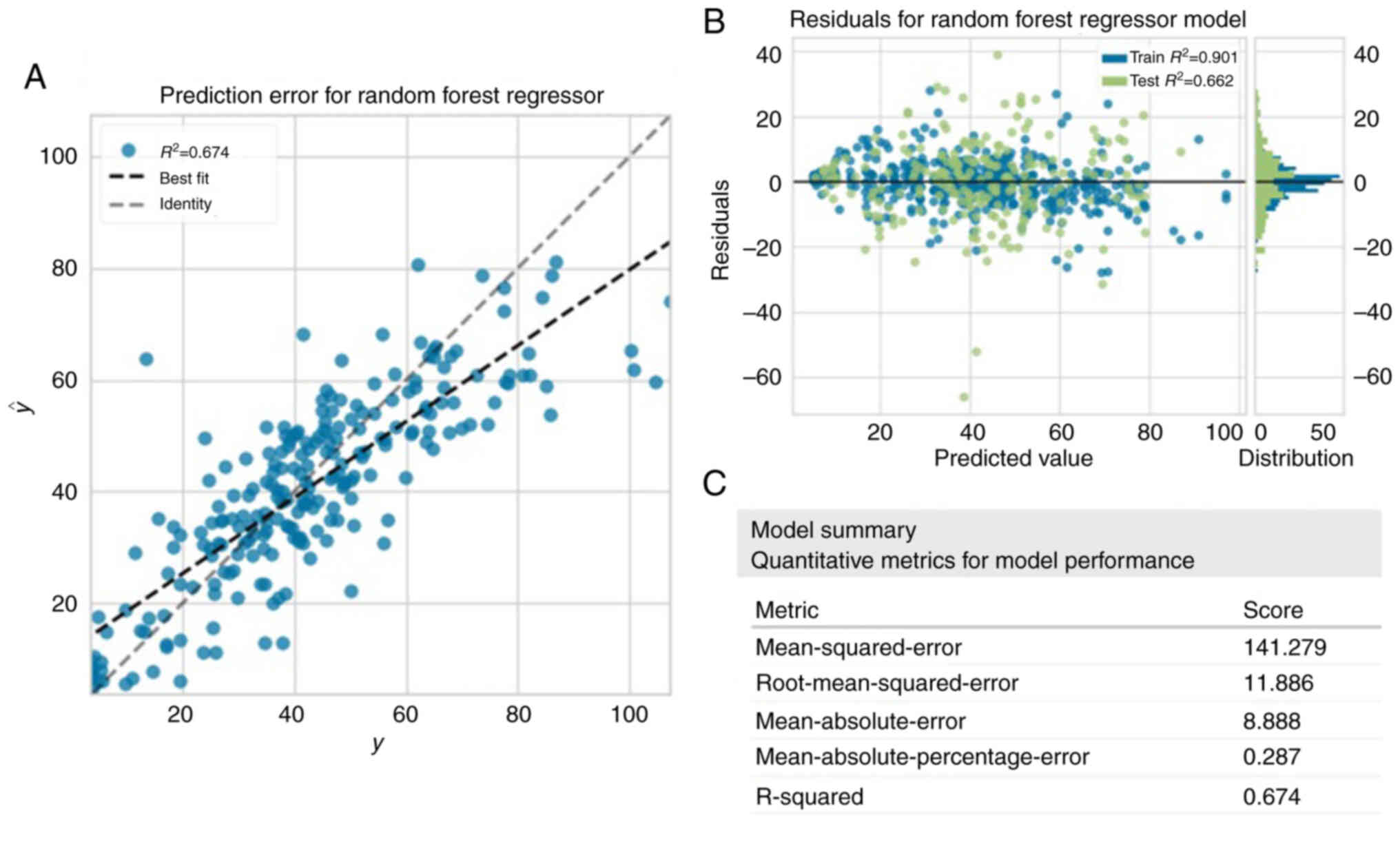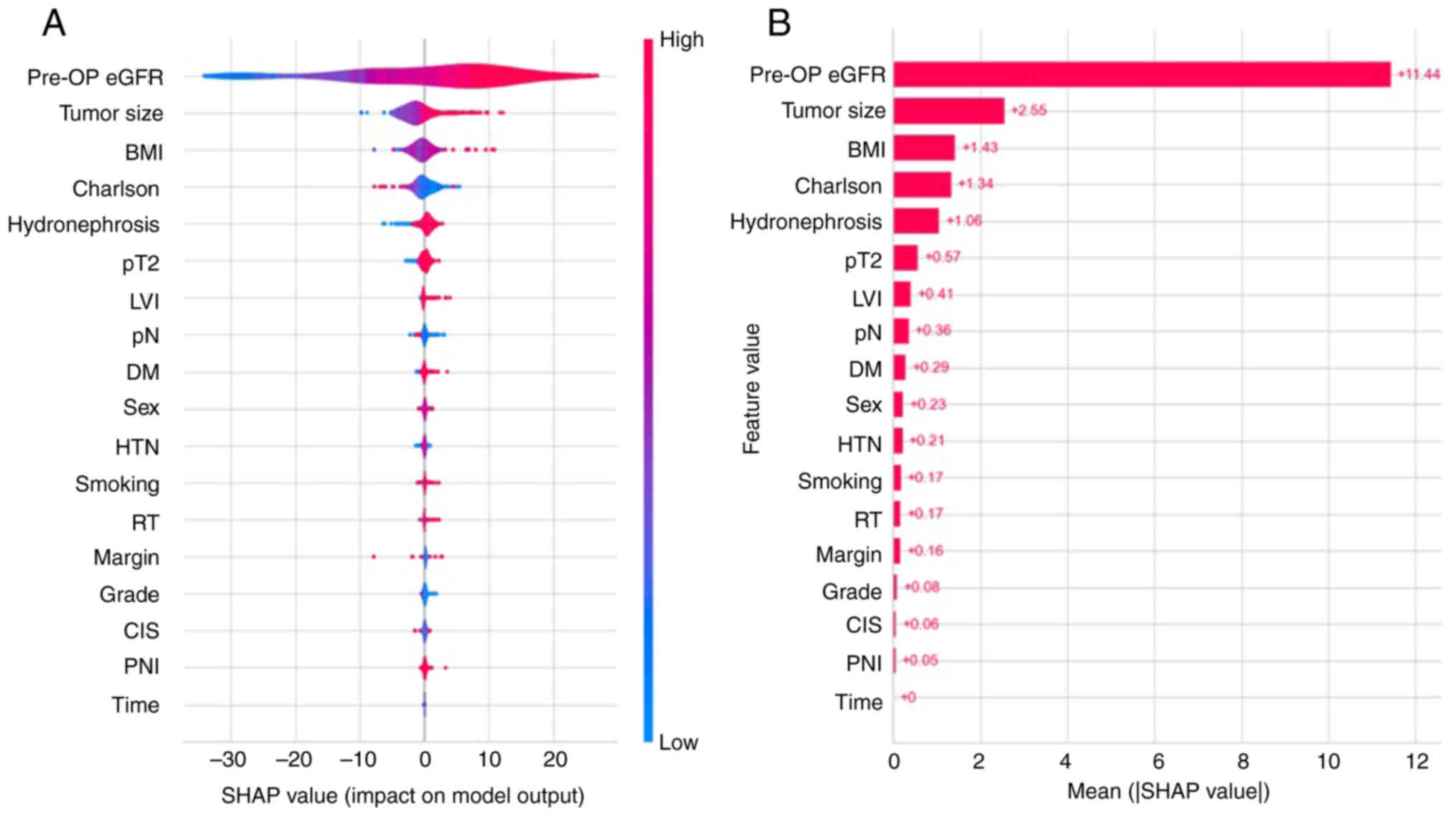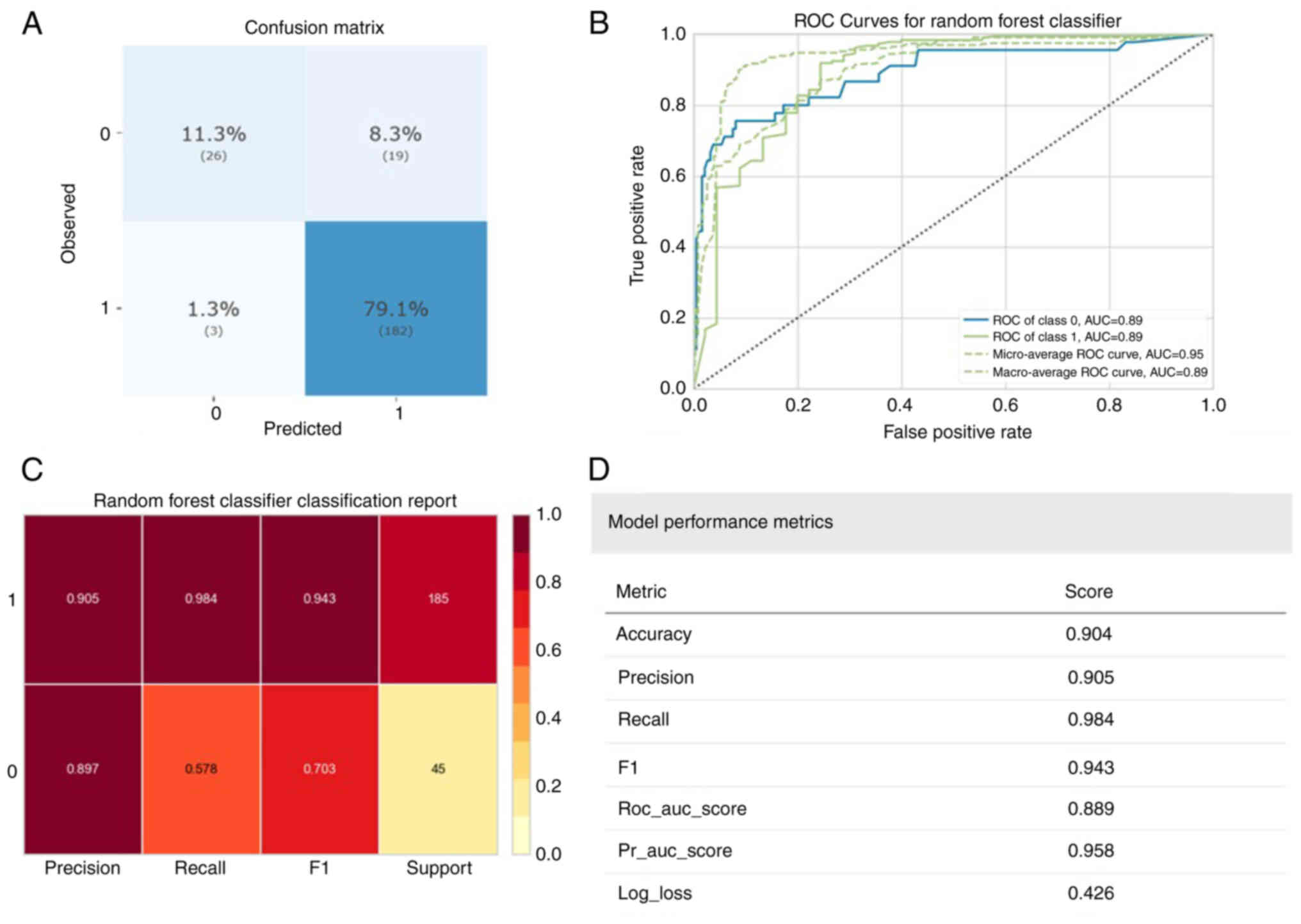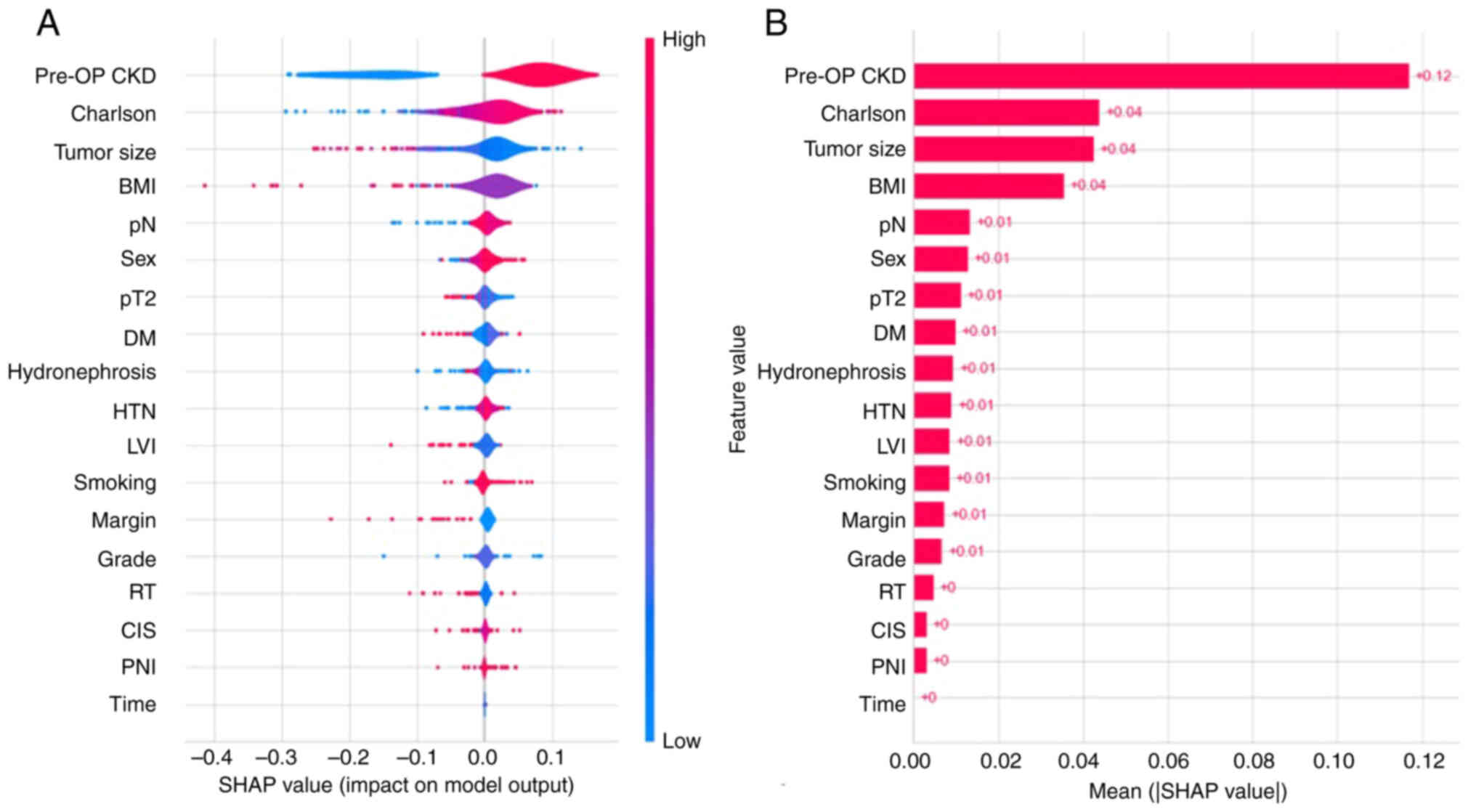Prediction of post‑nephroureterectomy renal function in non‑dialysis upper tract urothelial carcinoma using machine learning with PyCaret and SHAP explanations
- Authors:
- Published online on: February 25, 2025 https://doi.org/10.3892/ol.2025.14946
- Article Number: 200
-
Copyright: © Lee et al. This is an open access article distributed under the terms of Creative Commons Attribution License.
Abstract
Introduction
Upper tract urothelial carcinoma (UTUC) accounts for ~40% of all UC cases, with a higher prevalence among women than men in Taiwan (1,2). The incidence of UTUC has been rising in previous years, predominantly impacting the elderly population (3,4). As UTUC is aggressive and ~60% of UTUCs are invasive at presentation, improving the oncological outcome is imperative, especially in the current comorbid patient population (5). Malnutritional status is also a poor prognostic factor of survival outcome in patients with UTUC receiving radical surgery (6).
Radical nephroureterectomy (RNU) with bladder cuff excision is a curative treatment in UTUC. Although early-stage disease achieves durable long-term control, the 5-year overall survival rate for patients with non-organ-confined UTUC is <50% and it drops to <35% for those with nodal metastases. Given the limited effectiveness of surgery alone in treating locally advanced UTUC, there is a crucial need to develop multimodal treatment strategies to improve the survival rates for patients with poor prognostic UTUC (7).
The optimal timing for perioperative systemic chemotherapy is still controversial. Cisplatin-based treatments are presently administered in both neoadjuvant chemotherapy (NAC) and adjuvant chemotherapy (AC) settings. The importance of AC for patients with the aim of a cure has been confirmed (8). However, patient eligibility must be evaluated, especially concerning renal function in relation to definitive surgical treatment. The eligibility for cisplatin-based chemotherapy decreases after RNU, as some patients are unable to benefit from the advantage of AC. A previous systematic review and meta-analysis reported that patients with nonmetastatic UTUC who received NAC before RNU experienced improved OS and CSS compared with those who underwent RNU alone (9). NAC has the potential to offer these patients the benefits of chemotherapy. However, NAC presents several disadvantages. Firstly, it may postpone definitive RNU, potentially allowing disease progression, especially in patients who are chemoresistant. Secondly, chemotherapy-related toxicities in NAC recipients can further delay surgery. Lastly, there is a risk of overtreatment in patients who do not have pathologically confirmed muscle-invasive disease (9).
A phase 3 randomized trial from the UK presented compelling evidence supporting the use of AC. These results showed a 55% improvement in disease-free survival at a median follow-up period of 30.3 months. This study showed the use of AC may be superior when compared with RNU alone. The primary disadvantage of AC in the treatment of patients with UTUC is the decline in renal function following RNU (8) In addition, in the clinical trial, a subgroup analysis revealed that patients treated with cisplatin experienced notable benefits, whereas those treated with carboplatin did not (8,9).
The decision to administer NAC is difficult due to challenges in obtaining an accurate diagnosis. Currently, conventional imaging and endoscopic biopsy often underestimate the cancer stage (10). Therefore, developing nomograms that predict an advanced pathological stage at RNU could enhance the ability to identify patients who are most likely to benefit from preoperative chemotherapy. The aim of the present study was to create a model to predict renal function after RNU for improved planning of perioperative chemotherapy.
Materials and methods
Study cohort and clinical characteristics
A total of 764 medical records of patients with non-metastatic UTUC who received RNU from January 2008 to December 2022 at Kaohsiung Medical University Hospital (Kaohsiung, Taiwan) and Kaohsiung Municipal Ta-Tung Hospital (Kaohsiung, Taiwan) were retrospectively included in the present study. The present study was approved by Kaohsiung Medical University Hospital ethics committee [approval no. KMUHIRB-E(I)-20180214]. The inclusion criteria used were as follows: i) Patients with UTUC; and ii) patients who underwent RNU. The exclusion criteria used were as follows: i) Patients undergoing dialysis; and ii) missing eGFR data from medical records. The included data was divided into the training (n=534) and testing (n=230) datasets. The flowchart of the inclusion process is shown in Fig. 1. The training dataset was used to preliminarily train the prediction model, and the model was subsequently tested using the testing dataset. Several demographic and clinicopathological parameters were collected to predict postoperative renal function, including preoperative estimated glomerular filtration rate (eGFR), tumor size, body mass index (BMI), Charlson Comorbidity Index (CCI), pathological tumor stage ≥2 (pT2), pathological lymph node stage ≥Nx/N0 (pN), lymphovascular invasion (LVI), diabetes mellitus (DM), sex, hypertension (HTN), smoking, radiotherapy (RT), surgical margin, grade, carcinoma in situ (CIS), perineural invasion (PNI) and time. The Chronic Kidney Disease (CKD)-Epidemiology Collaboration equation was used to calculate the GFR, defined as: GFR=141 × min(Scr/κ, 1)α × max(Scr/κ, 1)−1.209 × 0.993age × 1.018 (if female) × 1.159 (if black), where Scr is serum creatinine (mg/dl), κ is 0.7 for women and 0.9 for men, α is-0.329 for female patients and −0.411 for male patients, min indicates the minimum of Scr/κ or 1 and max indicates the maximum of Scr/κ or 1 (11). The definition of CKD according to current The Kidney Disease: Improving Global Outcomes international guidelines (2012) is GFR <60 ml/min per 1.73 m2 (12,13).
Statistical analysis
The unpaired t-test (normalized data) and Mann-Whitney U test (non-normalized data) were used to assess the association between the dependent variable and continuous variables, respectively. Pearson's chi-square test or Fisher's exact test were used to assess the association between dependent and categorical variables. P<0.05 was used to indicate a statistically significant difference.
Linear regression is a foundational algorithm in machine learning that predicts continuous outcomes by modeling the relationship between independent and dependent variables. Logistic regression estimates probabilities using the logistic function and is employed for binary classification tasks. Regularization techniques like Lasso regression and Ridge regression address overfitting by penalizing large coefficients. The Elastic Net combines both Lasso and Ridge penalties for greater flexibility. Huber Regression is robust to outliers, blending squared and absolute loss functions. Support Vector Machines are versatile for classification and regression, leveraging hyperplanes for separation. K-Nearest Neighbors is a simple, non-parametric method relying on proximity for predictions. Naïve Bayes assumes feature independence and is efficient for text classification. Decision Trees provide interpretable models by splitting data hierarchically, while ensemble methods like Gradient Boosting, XGBoost, LightGBM, AdaBoost, CatBoost, Random Forest and Extra Trees combine multiple models to enhance performance. Least-angle regression and its Lasso variant are efficient for high-dimensional data. Orthogonal Matching Pursuit is a greedy algorithm for sparse representation to make locally optimal choices at each step and find a global optimum solution. Dummy Regression serves as a baseline model. Passive-aggressive regression is designed for online learning scenarios (14).
All analyses were performed using Python (version 3.11; Python Software Foundation), and machine learning algorithm was implemented with the PyCaret 3.0.4 package (Moez Ali), on a 64-bit Windows 11 (Microsoft Corporation) computer. PyCaret was used for data preprocessing and training the model with the available algorithms using a 10-fold cross-validation. Hyperparameter tuning was automatically performed via random grid search. The dataset was split into a 70% training set for model development and a 30% test set for validation. The regression was used to establish the prediction model for the continuous target (eGFR) and the classification model was used for the category target (CKD). To assess the accuracy of the machine learning models, R2 and accuracy (the proportion of all classifications that were correct) were utilized as performance evaluations for predicting eGFR and CKD, respectively. The best model with the highest accuracy would be further explored, and the ROC curve was formulated according to the model. The SHapley Additive exPlanations (SHAP) method was used to identify key feature factors, presenting individual SHAP values in a violin plot, and the ranking of the mean absolute SHAP values were shown in a bar chart to represent the impact mode of features and the importance ranking.
Results
Distribution of patient characteristics
There was no significant difference between the median age of the training [70 (64–76) years] and the testing [69 (63–76) years] datasets (Table I), and 48.9% of the training dataset were male compared with 43.9% of the testing dataset. In addition, there were no significant differences in patient characteristics (BMI, preoperative eGFR, DM, HTN, hydronephrosis, RT, CCI, time, and preoperative CKD) and tumor characteristics (pT2, pN, grade, LVI, PNI, surgical margin, CIS, and tumor size) between the training and test sets.
Table I.Characteristics and distribution of patients after radical nephroureterectomy in the training and testing datasets. |
Prediction of postoperative eGFR
As shown in Table II, the Random Forest Regressor outperformed the other algorithms and achieved the highest average score across multiple indicators. Fig. 2A illustrated the correlation between the predicted and actual values of eGFR when using Random Forest Regressor, showing that the model tended to overestimate when the actual value was low and underestimate when the actual value was high. Both the training and test sets achieved an R2 >0.6, and there was a larger residual in the test set compared with the training set (Fig. 2B). The summary of the model performance was assessed, including the mean square error (141.279), root mean squared error (11.886), mean absolute error (8.888), mean absolute percentage error (0.287) and R2 (0.674) (Fig. 2C). The R2 showed that the model explained more than one-half of the variance.
Table II.Performance of 20 machine learning algorithms for predicting estimated glomerular filtration rate in the training dataset. |
The SHAP method identified the importance of features for the Random Forest Regressor model, and violin and bar plots were used to evaluate the correlation between features and predicted values, as well as their importance in prediction. In the violin plot (Fig. 3A), the higher feature value was colored red and the lower feature value was colored blue. If the red points are distributed on right side of center axis (SHAP value=0), it means that a higher feature value corresponds to a higher SHAP value. On the contrary, the higher feature value is associated with the lower SHAP value when the red points are scattered on the left. In the bar plots shown in Fig. 3B, all features were sorted by the mean absolute SHAP values (Fig. 3B). Preoperative eGFR, tumor size, BMI, CCI and hydronephrosis were the top five factors attributed to prediction, among which preoperative eGFR had the greatest contribution to the model for prediction. The features in the top five showed a positive correlation with the SHAP value, except for CCI. Other features, including pT stage, LVI, pN stage, DM, sex, HTN, smoking, RT, surgical margin, grade, CIS and PNI also had medium to small contributions to predicting post-operative eGFR. The ability to predict time was minimal.
Prediction of postoperative CKD status
Regarding CKD, the Random Forest Classifier, with the best accuracy, also had the highest accuracy compared with other algorithms regarding the predicted index scores (Table III). The model's performance is illustrated in Fig. 4, with the confusion matrix results (Fig. 4A) indicating that 208 (90.4%) patients were accurately classified, 182 (79.1%) were patients with CKD and 26 (11.3%) were healthy controls. Fig. 4B displays the receiver operating characteristic (ROC) curve for the best model. However, the model's performance in predicting healthy groups was lower compared with patients with CKD (Fig. 4C). The overall model performance is summarized in Fig. 4D, with accuracy (0.904), precision (0.905), recall (0.984) and F1 score (0.943) all >0.9. In Fig. 5, the results from the SHAP method were consistent with the eGFR prediction analysis, with preoperative CKD serving as the most notable role for predicting the post-operative CKD status. The top four factors with the highest SHAP values were preoperative CKD, CCI, tumor size and BMI. Preoperative CKD and higher CCI had above-average SHAP values, while higher BMI and tumor size had below-average SHAP values. Other characteristics, including pT stage, LVI, pN stage, DM, sex, HTM, smoking, RT, surgical margin, grade, CIS, hydronephrosis and PNI, were also of similar importance in predicting postoperative CKD. The SHAP values for time were almost zero.
Table III.Performance of 16 machine learning algorithms for predicting chronic kidney disease in the training dataset. |
Discussion
For patients with advanced UTUC, optimum timing of perioperative systemic treatment is important to decrease cancer progression and recurrence. Although NAC can be a good strategy to decrease the stage of the tumor, there is a lack of confidence in the existing staging methods before surgery (15). The issue of over-staging and the subsequent over-treatment is a concern. However, some patients who are eligible for chemotherapy before surgery may become ineligible after surgery. Factors predicting a decline in renal function due to RNU may help identify patients at the highest risk of becoming ineligible for postoperative cisplatin treatment.
In the present retrospective study, a machine learning model that focused on preoperative prediction accuracy was adopted and included 18 different feature values for predicting renal function insufficiency postoperatively. The findings indicated that the Random Forest algorithms outperformed other models in both regression and classification tasks. In the regression analysis, a slight difference in residual distribution was observed between the training and testing datasets, which may be attributed to limitations in potential features and sample size. Regarding classification, the prediction of postoperative CKD appears to strongly depend on the preoperative CKD status. Most patients with preoperative CKD remain in a CKD state post-surgery. However, for individuals with normal renal function in the healthy group, postoperative CKD cannot be reliably predicted based on preoperative renal function alone. Furthermore, SHAP was utilized to gain insights into the importance and impact of clinical features on predictions, making the machine learning model more interpretable. Integrating clinical risk factors into a prediction model enhances preoperative personalized risk assessment and helps determine the best timing for perioperative cisplatin-based chemotherapy.
Random Forest provides insights into feature importance, aiding in feature selection and model interpretability. It has robustness and high accuracy and can reduce overfitting. In addition to being computationally intensive, it may struggle with small datasets where individual trees lack sufficient diversity. While it provides feature importance, the overall model is less interpretable compared with simpler algorithms like linear regression (16,17). In the present dataset, most patients had CKD before surgery, which may have contributed to the high accuracy of the model. The prediction of postoperative CKD depends largely on the preoperative CKD status. The prediction model was less effective in the preoperative CKD group in predicting the postoperative CKD status compared with the healthy control group. Therefore, it is necessary to establish different prediction models based on the presence or absence of CKD before surgery.
In the present study, from the analysis of eGFR and CKD outcomes, preoperative eGFR, tumor size, BMI and CCI were the main predictors of postoperative renal function. It has been previously shown that numerous clinical factors such as preoperative eGFR <60 ml/min, increased age, coronary artery disease and acute kidney injury on postoperative day 1 have been identified as being associated with poorer renal function outcomes after RNU, highlighting that preoperative renal function serves a crucial role in preserving postoperative function (18). Kaag et al (19) reported that there is a postoperative decline in renal function that does not improve over time observed between the early (1–5 months) and late (>5 months) postoperative time points. In addition, the authors discovered that older patients with lower preoperative eGFR tend to have a poorer renal function decline after surgery (19). Rodríguez Faba et al (20) also identified that some factors can predict postoperative impaired renal function including preoperative eGFR and hydronephrosis. Song et al (21) reported that preoperative renal function and contralateral kidney volume can predict new-onset CKD after surgery based on a multivariate logistic regression analysis, and that a small contralateral kidney volume is associated with a risk of postoperative CKD. The results of the present study indicated that BMI is an independent risk factor for renal function decline following RNU. Obesity is associated with a significantly increased risk for CKD progression. However, malnutrition is a prevalent issue among patients with cancer who often progress to cachexia, which can result in a diminished response to treatment, a poorer prognosis and a reduced quality of life. While the link between obesity and CKD progression is intricate, its adverse impact has been shown in several previous studies (21–23).
In the present study, hydronephrosis was demonstrated to be a predictive factor for postoperative renal function decline. Kanno et al (24) also discovered that the severity of hydronephrosis has a notable impact on postoperative renal function decline. The aforementioned study also reported that moderate to severe hydronephrosis, but not mild hydronephrosis, was associated with a slight decrease in renal function after surgery. The difference between preoperative and postoperative renal function is larger in patients without hydronephrosis or mild hydronephrosis compared with severe hydronephrosis (24). Similarly, a study by Singla et al (25) revealed that patients with hydronephrosis receiving surgery experience a smaller decrease in renal function compared with those without hydronephrosis. A possible explanation for the findings of the present study is that hydronephrosis was consistently associated with a thinner renal cortex and lower eGFR (25). The overall renal function would be compensated by the opposite kidney, so removing the impaired kidney would not lead to a marked drop in total eGFR. A smaller tumor size predicted impaired postoperative overall renal function as this would be compensated by the opposite kidney, which is in accordance with a previous study (26), suggesting that a larger tumor size would be associated with decreased function in the affected kidney; therefore, it is a protective factor for postoperative eGFR after accounting for preoperative renal function. Based on this concept, split renal function studies using nuclear renal scans may offer preoperative contralateral kidney function information, which could serve a key role in predicting postoperative renal function following surgery.
Compared with previous studies (27–29), the present model demonstrates greater flexibility, effectively accommodating both linear and non-linear outcome distributions. Furthermore, the performance of various models was evaluated to ensure the final selection achieved optimal accuracy. However, the present study does have some limitations. Firstly, although 18 features were included in the prediction model, there may be other important features such as tumor variants, cardiovascular disease, impact of medication and patient age, that were not added, as these may not have been collected or the data were missing. Secondly, this is a retrospective design study from a single institution and the number of cases is limited. Therefore, the original data may limit the reliability and accuracy of the model. Additionally, some patients were excluded from the present study due to the lack of complete preoperative data. Nevertheless, the present research provides important predictive factors that are associated with postoperative renal function decline. The predictors identified in the present study may be used for treatment planning strategies especially perioperative systemic chemotherapy.
To conclude, preoperative eGFR, tumor size, BMI, CCI and hydronephrosis were found to be independent predictors of postoperative eGFR in patients with UTUC. The correlation between the predicted and observed postoperative eGFR and CKD demonstrated a strong relationship. While further research is required to validate these findings, the machine learning model based on these factors could be valuable for identifying patients with impaired renal function after RNU and those who may be suitable for NAC.
Acknowledgements
Not applicable.
Funding
The present study was partially supported by the Ministry of Science and Technology (grant nos. MOST-111-2314-B-037-100-MY2 and NSTC 113-2314-B-037-027), Kaohsiung Medical University Hospital (grant nos. KMUH-111-1R55 and KMUH-112-2R57) and Regenerative Medicine and Cell Therapy Research Center (grant no. KMU-TC112A02).
Availability of data and materials
The data generated in the present study are included in the figures and tables of this article.
Authors' contributions
Conception and design was performed by HYL, HCY, WML, WJW and HLK. Acquisition of data and analysis was performed by YCW and CCL. YCW and HYL analyzed and interpreted the data. HYL drafted the manuscript. HYL and YCW confirm the authenticity of all the raw data. All authors read and approved the final version of the manuscript.
Ethics approval and consent to participate
The present study was approved by the institutional review board of Kaohsiung Medical University Hospital (Kaohsiung, Taiwan; approval no. KMUHIRB-E(I)-20180214). A waiver for consent to participate was granted by the IRB/Ethics Committee for this purpose.
Patient consent for publication
Not applicable.
Competing interests
The authors declare that they have no competing interests.
References
|
Han J, Xian Z, Zhang Y, Liu J and Liang A: Systematic overview of aristolochic acids: Nephrotoxicity, carcinogenicity, and underlying mechanisms. Front Pharmacol. 10:6482019. View Article : Google Scholar : PubMed/NCBI | |
|
Chang YH, Hsu WL, Lee YK, Chiang CJ, Yang YW, You SL, Chen YC and Lai TS: Trends and sex-specific incidence of upper urinary tract cancer in Taiwan: A birth cohort study. Cancer Med. 12:15350–15357. 2023. View Article : Google Scholar : PubMed/NCBI | |
|
Yeh HC, Chang CH, Fang JK, Chen IHA, Lin JT, Hong JH, Huang CY, Wang SS, Chen CS, Lo CW, et al: The value of preoperative local symptoms in prognosis of upper tract urothelial carcinoma after radical nephroureterectomy: A retrospective, multicenter cohort study. Front Oncol. 12:8728492022. View Article : Google Scholar : PubMed/NCBI | |
|
Chen IA, Chang CH, Huang CP, Wu WJ, Li CC, Chen CH, Huang CY, Lo CW, Yu CC, Tsai CY, et al: Factors predicting oncological outcomes of radical nephroureterectomy for upper tract urothelial carcinoma in Taiwan. Front Oncol. 11:7665762022. View Article : Google Scholar : PubMed/NCBI | |
|
Margulis V, Shariat SF, Matin SF, Kamat AM, Zigeuner R, Kikuchi E, Lotan Y, Weizer A, Raman JD and Wood CG; Upper Tract Urothelial Carcinoma CollaborationThe Upper Tract Urothelial Carcinoma Collaboration, : Outcomes of radical nephroureterectomy: A series from the upper tract urothelial carcinoma collaboration. Cancer. 115:1224–1233. 2009. View Article : Google Scholar : PubMed/NCBI | |
|
Chang LW, Hung SC, Chen CS, Li JR, Chiu KY, Wang SS, Yang CK, Lu K, Chen CC, Wang SC, et al: Geriatric nutritional risk index as a prognostic marker for patients with upper tract urothelial carcinoma receiving radical nephroureterectomy. Sci Rep. 13:45542023. View Article : Google Scholar : PubMed/NCBI | |
|
Abouassaly R, Alibhai SMH, Shah N, Timilshina N, Fleshner N and Finelli A: Troubling outcomes from population-level analysis of surgery for upper tract urothelial carcinoma. Urology. 76:895–901. 2010. View Article : Google Scholar : PubMed/NCBI | |
|
Birtle A, Johnson M, Chester J, Jones R, Dolling D, Bryan RT, Harris C, Winterbottom A, Blacker A, Catto JWF, et al: Adjuvant chemotherapy in upper tract urothelial carcinoma (the POUT trial): A phase 3, open-label, randomised controlled trial. Lancet. 395:1268–1277. 2020. View Article : Google Scholar : PubMed/NCBI | |
|
Leow JJ, Chong YL, Chang SL, Valderrama BP, Powles T and Bellmunt J: Neoadjuvant and adjuvant chemotherapy for upper tract urothelial carcinoma: A 2020 systematic review and meta-analysis, and future perspectives on systemic therapy. Eur Urol. 79:635–654. 2021. View Article : Google Scholar : PubMed/NCBI | |
|
Petros FG, Qiao W, Singla N, Clinton TN, Robyak H, Raman JD, Margulis V and Matin SF: Preoperative multiplex nomogram for prediction of high-risk nonorgan-confined upper-tract urothelial carcinoma. Urol Oncol. 37:292.e1–292.e9. 2019. View Article : Google Scholar : PubMed/NCBI | |
|
Levey AS, Stevens LA, Schmid CH, Zhang YL, Castro AF III, Feldman HI, Kusek JW, Eggers P, Van Lente F, Greene T, et al: A new equation to estimate glomerular filtration rate. Ann Intern Med. 150:604–612. 2009. View Article : Google Scholar : PubMed/NCBI | |
|
Webster AC, Nagler EV, Morton RL and Masson P: Chronic kidney disease. Lancet. 389:1238–1252. 2017. View Article : Google Scholar : PubMed/NCBI | |
|
Kidney Disease: Improving Global Outcomes (KDIGO) CKD-MBD Work Group: KDIGO clinical practice guideline for the diagnosis, evaluation, prevention, and treatment of chronic kidney disease-mineral and bone disorder (CKD-MBD). Kidney Int Suppl. 76 (Suppl 113):S1–S130. 2009. | |
|
Ray S: ‘A quick review of machine learning algorithms’. 2019 International Conference on Machine Learning, Big Data, Cloud and Parallel Computing (COMITCon); Faridabad, India: pp. 35–39. 2019 | |
|
Favaretto RL, Shariat SF, Savage C, Godoy G, Chade DC, Kaag M, Bochner BH, Coleman J and Dalbagni G: Combining imaging and ureteroscopy variables in a preoperative multivariable model for prediction of muscle-invasive and non-organ confined disease in patients with upper tract urothelial carcinoma. BJU Int. 109:77–82. 2012. View Article : Google Scholar : PubMed/NCBI | |
|
Qi Y: Random forest for bioinformatics. Zhang C and Ma Y: Ensemble Machine Learning. Springer; New York, NY: pp. 307–323. 2012 | |
|
Smith PF, Ganesh S and Liu P: A comparison of random forest regression and multiple linear regression for prediction in neuroscience. J Neurosci Methods. 220:85–91. 2013. View Article : Google Scholar : PubMed/NCBI | |
|
Tafuri A, Marchioni M, Cerrato C, Mari A, Tellini R, Odorizzi K, Veccia A, Amparore D, Shakir A, Carbonara U, et al: Changes in renal function after nephroureterectomy for upper urinary tract carcinoma: Analysis of a large multicenter cohort (radical nephroureterectomy outcomes (RaNeO) research consortium). World J Urol. 40:2771–2779. 2022. View Article : Google Scholar : PubMed/NCBI | |
|
Kaag M, Trost L, Thompson RH, Favaretto R, Elliott V, Shariat SF, Maschino A, Vertosick E, Raman JD and Dalbagni G: Preoperative predictors of renal function decline after radical nephroureterectomy for upper tract urothelial carcinoma. BJU Int. 114:674–679. 2014. View Article : Google Scholar : PubMed/NCBI | |
|
Rodríguez Faba O, Palou J, Breda A, Maroto P, Fernández Gómez JM, Wong A and Villavicencio H: Predictive factors for impaired renal function following nephroureterectomy in upper urinary tract urothelial cell carcinoma. Urol Int. 92:169–173. 2014. View Article : Google Scholar : PubMed/NCBI | |
|
Song W, Sung HH, Han DH, Jeong BC, Seo SI, Jeon SS, Lee HM, Choi HY and Jeon HG: The effect of contralateral kidney volume on renal function after radical nephroureterectomy: Implications for eligibility for neoadjuvant chemotherapy for upper tract urothelial cancer. Urol Oncol. 35:114.e1–114.e7. 2017. View Article : Google Scholar : PubMed/NCBI | |
|
Yun HR, Kim H, Park JT, Chang TI, Yoo TH, Kang SW, Choi KH, Sung S, Kim SW, Lee J, et al: Obesity, metabolic abnormality, and progression of CKD. Am J Kidney Dis. 72:400–410. 2018. View Article : Google Scholar : PubMed/NCBI | |
|
Madero M, Katz R, Murphy R, Newman A, Patel K, Ix J, Peralta C, Satterfield S, Fried L, Shlipak M and Sarnak M: Comparison between different measures of body fat with kidney function decline and incident CKD. Clin J Am Soc Nephrol. 12:893–903. 2017. View Article : Google Scholar : PubMed/NCBI | |
|
Kanno T, Kobori G, Saito R, Ito K, Nakagawa H, Takahashi T, Koterazawa S, Takaoka N, Somiya S, Haitani T, et al: Hydronephrosis severity as a predictor of postoperative renal function decline following laparoscopic radical nephroureterectomy. Int J Clin Oncol. 29:464–472. 2024. View Article : Google Scholar : PubMed/NCBI | |
|
Singla N, Hutchinson R, Haddad A, Sagalowsky A, Lotan Y and Margulis V: Preoperative hydronephrosis is associated with less decline in renal function after radical nephroureterectomy for upper tract urothelial carcinoma. Can J Urol. 23:8334–8341. 2016.PubMed/NCBI | |
|
Fang D, Zhang Q, Li X, Qian C, Xiong G, Zhang L, Chen X, Zhang X, Yu W, He Z and Zhou L: Nomogram predicting renal insufficiency after nephroureterectomy for upper tract urothelial carcinoma in the Chinese population: Exclusion of ineligible candidates for adjuvant chemotherapy. Biomed Res Int. 2014:5291862014. View Article : Google Scholar : PubMed/NCBI | |
|
Hashimoto T, Ohno Y, Nakashima J, Gondo T, Nakagami Y, Namiki K, Horiguchi Y, Yoshioka K, Ohori M and Tachibana M: Prediction of renal function after nephroureterectomy in patients with upper tract urothelial carcinoma. Jpn J Clin Oncol. 45:1064–1068. 2015. View Article : Google Scholar : PubMed/NCBI | |
|
Hensley PJ, Labbate C, Zganjar A, Howard J, Huelster H, Durdin T, Pham J, Xiao L, Pallauf M, Lombardo K, et al: Development and validation of a multivariable nomogram predictive of post-nephroureterectomy renal function. Eur Urol Oncol. 7:1313–1319. 2024. View Article : Google Scholar : PubMed/NCBI | |
|
Liu J, Wu P, Lai S, Wang J, Hou H and Zhang Y: Prognostic models for upper urinary tract urothelial carcinoma patients after radical nephroureterectomy based on a novel systemic immune-inflammation score with machine learning. BMC Cancer. 23:5742023. View Article : Google Scholar : PubMed/NCBI |



